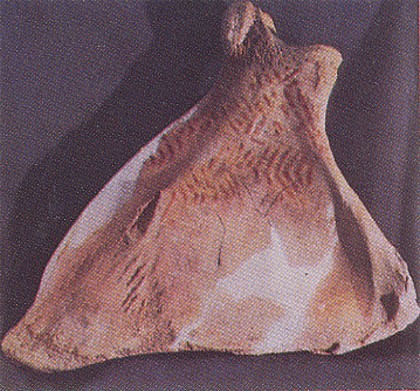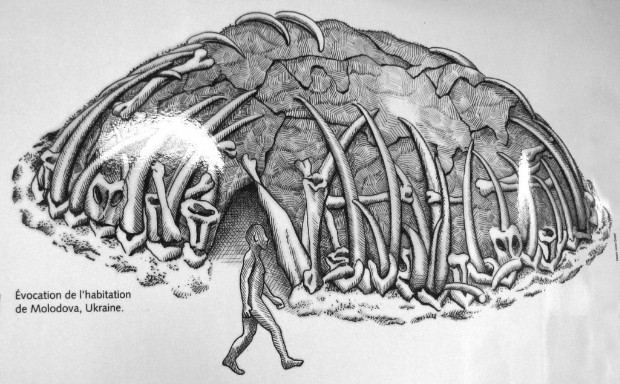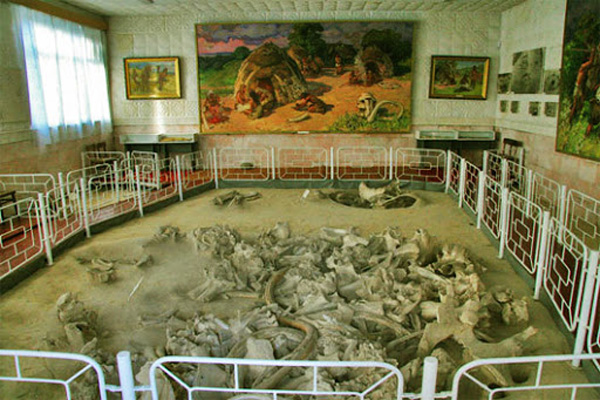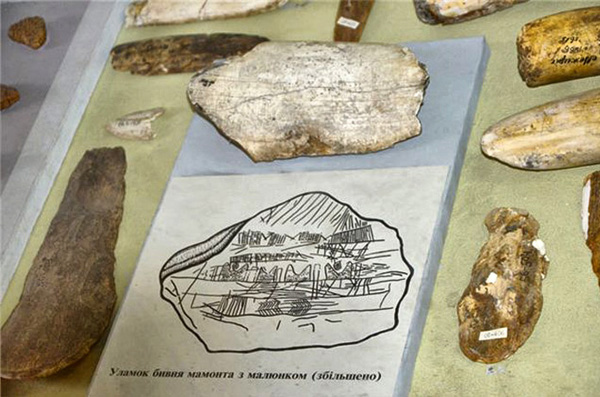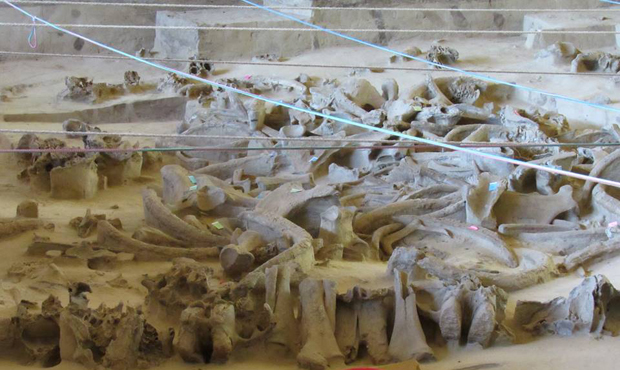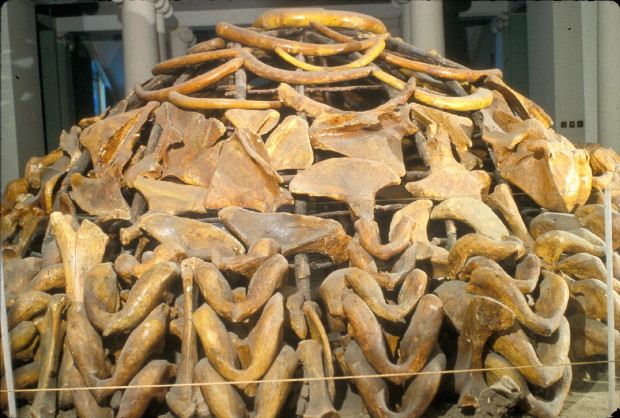Paleolithic Period
Paleolithic Period [Палеоліт; Paleolit]. The earliest period of human development, lasting until approximately 8000 BC. In Western archeology the Paleolithic Period (or Old Stone Age) is divided into three epochs: the Lower Paleolithic (from roughly 3 million years ago to approximately 300,000 BC), the Middle Paleolithic (approximately 300,000–40,000 BC), and the Upper Paleolithic (approximately 40,000–10,000 BC). These, in turn, consist of several eras or cultures; for example, the Upper Paleolithic period is subdivided into the Aurignacian, Gravettian, Perigoridian, Sultrean cultures as well as the Magdalenian culture. Notwithstanding some significant differences between Ukrainian and (Western) European Paleolithic cultures, Ukrainian archeological studies follow this basic scheme.
The Paleolithic Period coincides with the geological age known as the Pleistocene, which is marked by a general cooling of the earth's temperature and the corresponding expansion and retreat of glaciers. The three successive waves of glaciations (known as the Mindel, Riss, and Würm glaciations in Western European nomenclature and by other names in Central and Northern European and Soviet classification schemata) that occurred in Europe from approximately 600,000 BC are of particular interest to the study of human development. The Pleistocene epoch ends at the same time as the historical Paleolithic Period (ca 10,000–8000 BC) with the final retreat of glaciation over most of Europe and the coming of a new, warmer geological age, the Holocene.
The oldest evidence of human presence in Ukraine has been found at the Korolevo archeological site in Transcarpathia and, recently, at the Medzhybizh archeological site in Podilia and has been dated to ca 950,000 BC. A small number of other Acheulean culture (ca 950,000–100,000 BC) sites have been excavated in Ukraine, providing evidence that early humans lived there in hunter-gatherer bands. However, evidence of substantial settlement in Ukraine begins only with the onset of the Mousterian culture (100,000–40,000 BC), occasionally referred to as the Middle Paleolithic. This period began with the mild temperatures of the Riss-Würm interglacial and then continued with the Würm glaciation, which caused temperatures to fluctuate as it moved back and forth in three phases lasting to 10,000–8000 BC. The population growth experienced in such a glacial period resulted partly from the early humans’ increasing ability to adapt to cold conditions. More important was the large number of game animals that could be hunted and the abundant vegetation cover which could be gathered in spite of the colder climate.
Mousterian culture sites have been discovered in Ukraine mainly in the middle-Dnister River (the Molodove archeological site) and Dnipro Rapids regions and in the hills of southern Crimea and in the Crimean Mountains (Kiik-Koba, Shaitan-Koba, the Starosilia archeological site). Such locations offered the shelter of river terraces or caves. Evidence indicates that surface dwellings were constructed somewhat similar in appearance to igloos, using animal skins and some form of posts on a foundation of animal bones (particularly mammoths). Remains of cave dwellings, temporary camping grounds, flint extraction locations, and flint workshops have also been found. The ubiquity of hearths in all forms of Mousterian shelters indicates that the ability to make fire had become widespread. A variety of locally made flint tools (particularly side-scrapers and points) have been unearthed at Mousterian sites, indicating a varied usage. Nevertheless, flint technology was not particularly well-developed in this period.
Mousterian culture humans lived by hunting and gathering. The game during this period included mammoths, the woolly rhinoceros, bisons, deer, wolves, and bears. Foods gathered included fruits, leaves, roots, bird eggs, and mollusks.
The Mousterian culture inhabitants of Ukraine were Neanderthals who lived in small groups that scholars believe may have been matriarchal and matrilineal. The fact that they buried their dead in a ritualized manner on their sides in a flexed position indicated that these people had probably developed at least a rudimentary religious consciousness.
A major change took place ca 40,000 BC when the Mousterian culture was supplanted by a series of Upper Paleolithic cultures. Although a direct causal link cannot be established, this was likely owing to the appearance of the (modern) Cro-Magnons (Homo sapiens) and the demise of the Neanderthals. The genesis of Cro-Magnons in Ukraine is a subject of debate, with some (mainly Soviet) scholars viewing this as an indigenous evolutionary process and others deducing that they migrated into Ukrainian lands. A burial of an apparently Cro-Magnon child surrounded by Neanderthal artefacts discovered at the Starosilia archeological site in the Crimea suggests that for a period of time at the end of the Mousterian period Neanderthals and Cro-Magnons lived in close proximity on the territory of today’s Ukraine and even occasionally interbred.
Significant developments took place at the end of the Mousterian period. One of the most obvious changes during the Upper Paleolithic was a remarkable increase in the variety of implements used and the quality of their manufacture. End-scrapers and burins became particularly widespread at this time. The manner in which flint was worked from cores was improved. Different types of raw materials, including bone, antler, and ivory, were commonly used. High-quality flint was actively sought and transported over long distances (possibly as a barter item).
Upper Paleolithic settlements tended to be more permanent than their Mousterian culture counterparts. They became also more widespread throughout Ukraine (with a concentration in the previously settled Dnister River and Dnipro River areas) as the population increased during this period. Hunting and gathering remained primary occupations, with evidence indicating considerable improvements in hunting technology and organization. Fishing became common during this time. Large Upper Paleolithic settlements of the Magdalenian culture, covering up to 10,000 sq m and featuring elaborate mammoth-bone dwellings, were excavated in the Mizyn archeological site, the Hintsi archeological site, the Mezhyrich archeological site, the Dobranichivka archeological site, and other sites in the Kyiv region, Chernihiv region, and Poltava region.
A fundamental change occurred in the Upper Paleolithic with the emergence of an esthetic consciousness. Whereas the remains of art objects are unknown at Mousterian culture sites, Upper Paleolithic discoveries include decorated bone, ivory, and antler objects, shell pendants, ivory bracelets, and ivory figurines of women, mammoths, and birds. Remains of flutes and bone percussion instruments indicate that Upper Paleolithic man also created music.
BIBLIOGRAPHY
Efimenko, P. Pervobytnoe obshchestvo (Kyiv 1953)
Boriskovskii, P. Paleolit Ukrainy (Moscow–Leningrad 1953)
Shovkoplias, I. ‘Piznii paleolit,’ in Arkheolohiia Ukraïns'koï RSR, vol 1 (Kyiv 1971)
Klein, R. Ice-Age Hunters of the Ukraine (Chicago 1973)
Chernysh, A. Paleolit i mezolit Pridnestrov'ia (Moscow 1973)
Hladylin, V. ‘Rannii paleolit’ in Arkheologiia Ukrainskoi SSR, vol 1 (Kyiv 1985)
Kolosov, Iu.; Stepanchuk, V.; Chabai, V. Rannii paleolit Kryma (Kyiv 1993)
Bibikov, S.; Stanko, V.; Koen, V. Final'nyi paleolit i mezolit Gornogo Kryma (Odesa 1994)
Hladkykh, M.; Stanko, V. ‘Epokha piznioho paleolitu’ in Davnia istoriia Ukraïny, vol 1 (Kyiv 1997)
Sytnyk, O. Serednii paleolit Podillia (Lviv 2000)
Stepanchuk, Vadym. ‘Nyzhnii i serednii paleolit Ukraïny: Khronolohichni ramky, antropolohichnyi typ nosiiv kul'tury, osnovni mistseznakhodzhennia reshtok vykopnykh liudei’ in Materiialy i doslidzhennia z arkheolohii Prykarpattia i Volyni, vyp 10 (Lviv 2006)
Iakovleva, Liudmyla. Naidavnishe mystetstvo Ukraïny (Kyiv 2013)
Andrij Makuch, Marko Robert Stech
[This article was updated in 2020.]

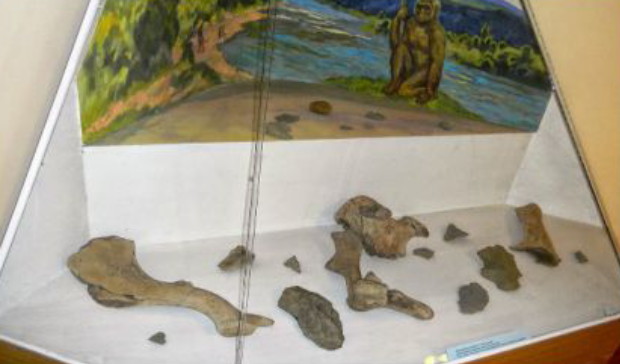
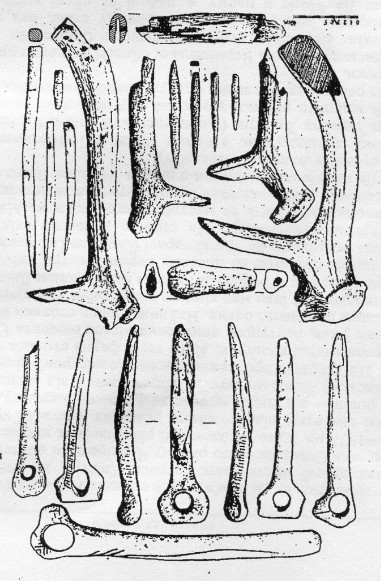
.jpg)
.jpg)
